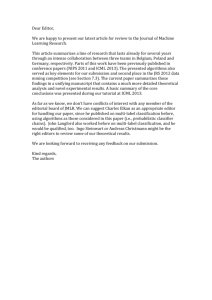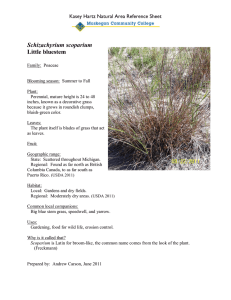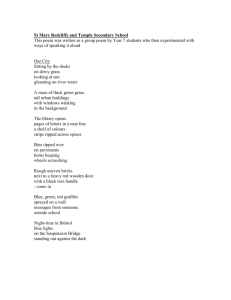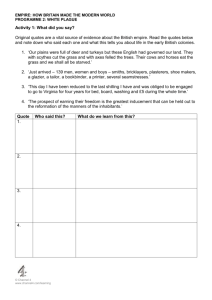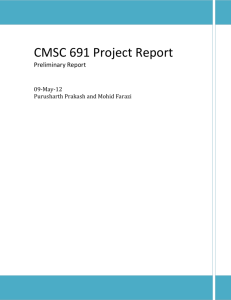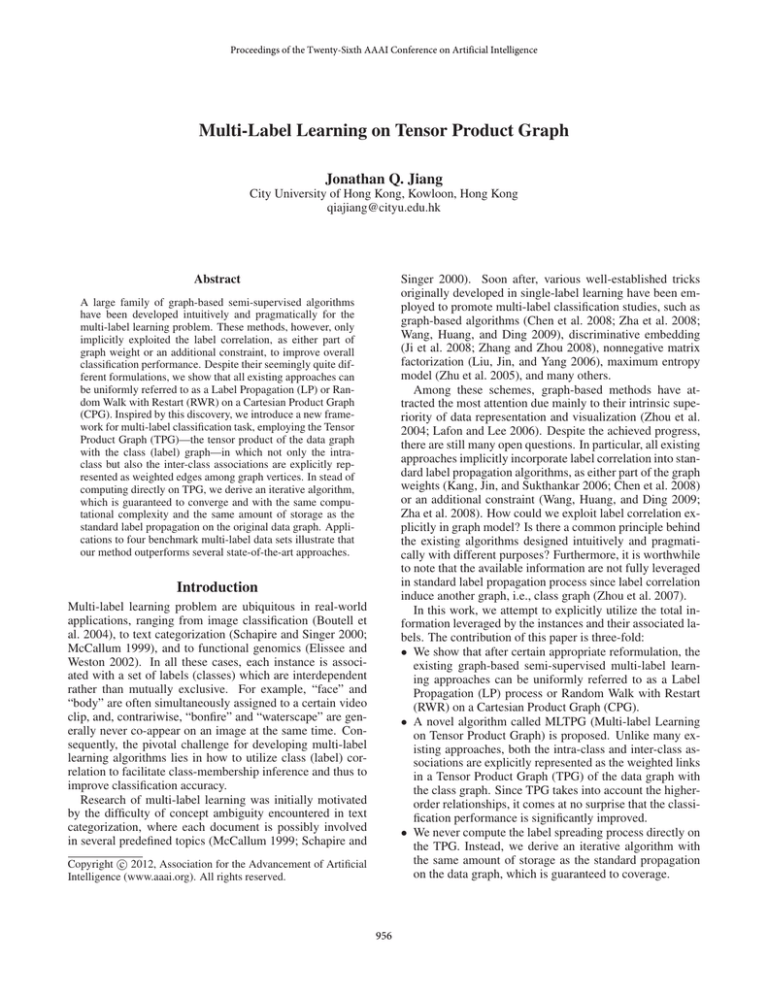
Proceedings of the Twenty-Sixth AAAI Conference on Artificial Intelligence
Multi-Label Learning on Tensor Product Graph
Jonathan Q. Jiang
City University of Hong Kong, Kowloon, Hong Kong
qiajiang@cityu.edu.hk
Abstract
Singer 2000). Soon after, various well-established tricks
originally developed in single-label learning have been employed to promote multi-label classification studies, such as
graph-based algorithms (Chen et al. 2008; Zha et al. 2008;
Wang, Huang, and Ding 2009), discriminative embedding
(Ji et al. 2008; Zhang and Zhou 2008), nonnegative matrix
factorization (Liu, Jin, and Yang 2006), maximum entropy
model (Zhu et al. 2005), and many others.
Among these schemes, graph-based methods have attracted the most attention due mainly to their intrinsic superiority of data representation and visualization (Zhou et al.
2004; Lafon and Lee 2006). Despite the achieved progress,
there are still many open questions. In particular, all existing
approaches implicitly incorporate label correlation into standard label propagation algorithms, as either part of the graph
weights (Kang, Jin, and Sukthankar 2006; Chen et al. 2008)
or an additional constraint (Wang, Huang, and Ding 2009;
Zha et al. 2008). How could we exploit label correlation explicitly in graph model? Is there a common principle behind
the existing algorithms designed intuitively and pragmatically with different purposes? Furthermore, it is worthwhile
to note that the available information are not fully leveraged
in standard label propagation process since label correlation
induce another graph, i.e., class graph (Zhou et al. 2007).
In this work, we attempt to explicitly utilize the total information leveraged by the instances and their associated labels. The contribution of this paper is three-fold:
• We show that after certain appropriate reformulation, the
existing graph-based semi-supervised multi-label learning approaches can be uniformly referred to as a Label
Propagation (LP) process or Random Walk with Restart
(RWR) on a Cartesian Product Graph (CPG).
• A novel algorithm called MLTPG (Multi-label Learning
on Tensor Product Graph) is proposed. Unlike many existing approaches, both the intra-class and inter-class associations are explicitly represented as the weighted links
in a Tensor Product Graph (TPG) of the data graph with
the class graph. Since TPG takes into account the higherorder relationships, it comes at no surprise that the classification performance is significantly improved.
• We never compute the label spreading process directly on
the TPG. Instead, we derive an iterative algorithm with
the same amount of storage as the standard propagation
on the data graph, which is guaranteed to coverage.
A large family of graph-based semi-supervised algorithms
have been developed intuitively and pragmatically for the
multi-label learning problem. These methods, however, only
implicitly exploited the label correlation, as either part of
graph weight or an additional constraint, to improve overall
classification performance. Despite their seemingly quite different formulations, we show that all existing approaches can
be uniformly referred to as a Label Propagation (LP) or Random Walk with Restart (RWR) on a Cartesian Product Graph
(CPG). Inspired by this discovery, we introduce a new framework for multi-label classification task, employing the Tensor
Product Graph (TPG)—the tensor product of the data graph
with the class (label) graph—in which not only the intraclass but also the inter-class associations are explicitly represented as weighted edges among graph vertices. In stead of
computing directly on TPG, we derive an iterative algorithm,
which is guaranteed to converge and with the same computational complexity and the same amount of storage as the
standard label propagation on the original data graph. Applications to four benchmark multi-label data sets illustrate that
our method outperforms several state-of-the-art approaches.
Introduction
Multi-label learning problem are ubiquitous in real-world
applications, ranging from image classification (Boutell et
al. 2004), to text categorization (Schapire and Singer 2000;
McCallum 1999), and to functional genomics (Elissee and
Weston 2002). In all these cases, each instance is associated with a set of labels (classes) which are interdependent
rather than mutually exclusive. For example, “face” and
“body” are often simultaneously assigned to a certain video
clip, and, contrariwise, “bonfire” and “waterscape” are generally never co-appear on an image at the same time. Consequently, the pivotal challenge for developing multi-label
learning algorithms lies in how to utilize class (label) correlation to facilitate class-membership inference and thus to
improve classification accuracy.
Research of multi-label learning was initially motivated
by the difficulty of concept ambiguity encountered in text
categorization, where each document is possibly involved
in several predefined topics (McCallum 1999; Schapire and
c 2012, Association for the Advancement of Artificial
Copyright Intelligence (www.aaai.org). All rights reserved.
956
Preliminaries
the appropriate form of the graph Laplacian and weighted
adjacency matrix.
Basic Graph Theory An undirected graph G(V, E) consists of a finite vertex set V , an edge set E and a weighted
adjacency matrix W ∈ <|V |×|V | which associates a positive scalar w(x, y) with each edge (x, y) ∈ E. Given a
specific vertex P
x, the degree function d : V → <+ is defined by dx = y:(x,y)∈E w(x, y). Let D = diag(dx )x∈V
be the diagonal degree matrix, the weighted adjacency matrix W can be symmetrically or asymmetrically normalized
1
1
as Ws = D− 2 W D− 2 and Wr = D−1 W , which corresponds to the standard LP process (Zhou et al. 2004) or
RWR (Chung 1997), respectively. In the existing literature, there are three related matrices called the graph Laplacian, and there does not appear to be a consensus on the
nomenclature (von Luxburg 2007). The unnormalized graph
Laplacian L is defined as L = D − W . There are also
two normalized graph Laplacian (Chung 1997), respectively
given by
1
1
Ls = D− 2 LD− 2 = I − Ws
Graph-based Semi-supervised Learning:
A Unified View
Problem Formulation Let D = {(xi , y i )}ni=1 be partially labeled data set with K classes, where each instance
xi ∈ <d is associated with a subset of class labels represented by a binary vector y i ∈ {0, 1}K such that y i (k) =
1 if xi belongs to the k-th class, and 0 otherwise. Let
G = (V, E) be an undirected graph over the data set,
where each vertex corresponds to an instance, and each edge
has a non-negative weight w(i, j) typically reflecting the
similarity between xi and xj . For convenience, we write
X = [x1 , · · · , xn ]T and Y = [y 1 , · · · , y n ]T . Suppose the
first l instances are already annotated, our goal is to predict labels {y i }ni=l+1 for unlabeled samples {xi }ni=l+1 . In
most cases, the learning system will generate a real-value
matrix F = [f 1 , . . . , f n ]T = [f 1 , . . . , f K ] = (fik ) ∈
<n×K where fik represents the likelihood of xi belonging to the k-th class. The learning problem on a partially
labeled graph G generally can be thought of seeking for
a classification function f : V → <K , which is sufficient smooth on closely related vertices, while simultaneously changes the initial label assignment as little as possible. This view can be formulated as the following optimization problem (Belkin, Matveeva, and Niyogi 2004;
Zhou and Schölkopf 2004)
arg min SG (f ) + µkf (x) − yk2F
(1)
Lr = D−1 L = I − Wr
Product Graph Given two graphs G0 (V 0 , E 0 ) and
G00 (V 00 , E 00 ), a graph product is a certain kind of binary
operation that produces a graph G(V, E) with |V 0 ||V 00 | vertices, each representing a pair of vertices from G0 and G00 ,
respectively. An edge exists in E iff the corresponding
vertices satisfy conditions of a certain type1 . Specifically,
in the Cartesian product graph G = G0 G00 , x =
(x0 , x00 ) adjacent with y = (y 0 , y 00 ) whenever x0 = y 0 and
(x00 , y 00 ) ∈ E 00 or x00 = y 00 and (x0 , y 0 ) ∈ E 0 ; an edge
exists in the tensor product graph G× = G0 × G00 iff the
corresponding vertices are adjacent in both G0 and G00 , respectively. Thus, E × = {((x0 , y 0 ), (x00 , y 00 )) : (x0 , y 0 ) ∈
E 0 ∧ (x00 , y 00 ) ∈ E 00 }. We refer the reader to (Harary 1994;
Knuth 2008) for further details on product graphs and their
properties and only review a necessary lemma which serves
as important foundation for our following analysis
Lemma 1. If W 0 and W 00 are the weighted adjacency matrices of graphs G0 and G00 , respectively, the weighted adjacency matrix of the Cartesian product graph G is W =
W 0 ⊕ W 00 , and the weighted adjacency matrix of the tensor
product graph G× is W × = W 0 ⊗ W 00 .
f ∈H(V )
PK
Single-label learning If
k=1 Yik = 1, i.e., each instance belongs to exactly one class, the data set is a singlelabel data set. Traditional single-label graph-based semisupervised learning approaches (Zhou et al. 2004; Wang and
Zhang 2006; Zhu, Ghahramani, and Lafferty 2003) only take
into account the data graph G beased on certain pairwise
similarity (or equivalently distance) metrics. In this case,
the smoothness term is usually formulated as
SG =
K
X
S k (f k ) =
T
f k Lf k = Tr F T (I − W)F
k=1
k=1
where⊕ and ⊗ denote the Kronecker sum and Kronecker
product, respectively. They are linked by the well-known
property: let A ∈ <n×n , B ∈ <m×m , and Ik denote the
k × k identity matrix, then A ⊕ B = A ⊗ Im + In ⊗ B.
K
X
(2)
Substituting Eq. (3) into regularization framework and differentiating it with respect to F , we get the iterative solution
(Zhou et al. 2004)
Notations AT , Tr(A), and ρ(A) denote the transpose, the
~ represents the
trace, and the spectral radius of matrix A. A
vectorization operator vec(A) that stacks the columns of matrix A one after the next into a column vector. k · k and k · kF
denotes the `2 -norm and F -norm, respectively. I always
denotes the identity matrix, its dimensions being apparent
from the context. The matrices L and W generally represent
F (t+1) = αWF (t) + (1 − α)Y
1
1+µ .
nK
(3)
n×K
where α =
Introducing an isomorphism <
=
n
K ∼
< ⊗< = <
between the spaces of matrix and vector
in coordinates to convert the matrix F into a column vector
F~ = [f 1 , . . . , f K ]T and vectorizing both sides
~
F~ (t+1) = α (W ⊗ I) F~ (t) + (1 − α)Y
1
There are 3 × 3 − 1 = 8 cases to be decided (three possibilities
for each, with the case where both are equal eliminated) and thus
there are 28 = 256 different types of graph products that can be
defined.
(4)
The matrix W ⊗ I is the adjacency matrix of a special product graph which can be understood as K independent copies
of the data graph G. Therefore, the single-label methods
957
Let α =
1
1+µ
and we have an iterative equation
F (t+1) = α(WF (t) + βF (t) W 0 ) + (1 − α)Y
(6)
Vectorizing both sides, it yields
~
F~ (t+1) = α(I ⊗ W + βW 0 ⊗ I)F~ (t) + (1 − α)Y
~
F~ (t+1) = α(βW 0 ⊕ W)F~ (t) + (1 − α)Y
0
(7)
0
where W = Ws and W = W in MLCF. The relationship
between MLCF and MLGF is similar to the relationship between LGC and GRF. Thus, MLGF is the same as MLCF
except for W being the adjacency matrix of unlabeled data
and α → 0.
In addition, Chen et al. proposed a new multi-label learning approach by solving a Sylvester equation (SMSE). The
solution is (Chen et al. 2008)
(1 − W)F + µ(F − Y ) + νF (1 − W 0 ) = 0
Figure 1: The key principles of different graph-based semisupervised learning algorithms. The symbol (i, k) denotes
that the instance xi belongs to the k-th class.
Let α =
µ+ν
1+µ+ν
and β =
ν
1+ν
(8)
and we have
F (t+1) = α((1 − β)WF (t) + βF (t) W 0 ) + (1 − α)Y (9)
perform the binary classification on K individual copies of
the data graph, each copy for one specific class (see Fig.
1(a)). The existing approaches rely on an almost identical formulation but only differ in details. In particular, the
Local and Global Consistency (LGC) method (Zhou et al.
2004) utilized the symmetrically normalized adjacency matrix W = Ws of the data graph G, which can be understood
as a label propagation process; the Gaussian Random Field
and harmonic function (GRF) method (Zhu, Ghahramani,
and Lafferty 2003) used the adjacency matrix corresponding
to unlabeled data, which is also a label propagation process
under the condition α → 0(µ → ∞); the Linear Neighborhood Propagation (LNP) method (Wang and Zhang 2006)
constructed the adjacency matrix through local linear coefficients and exploited the asymmetrically normalized adjacency matrix W = Wr that corresponds to a personalized
random walk.
PK
Multi-label learning If k=1 Yik ≥ 1, i.e., each instance
is possibly associated with more than one class label, the
data set is a multi-label data set. In this scenario, the label
correlation among different classes induces another graph,
the class graph G0 (V 0 , E 0 ), where V 0 = {1, . . . , K} and
E 0 ⊆ V 0 ×V 0 . Zha et al. introduced two multi-label learning
algorithms, called Multi-label Gaussian harmonic function
(MLGF) method, and Multi-label local global consistency
(MLCF) method, by incorporating the correlations among
multiple labels into the single-label approaches GRF and
LCF respectively. Let W 0 be the appropriate adjacency matrix of class graph G0 , the solution of MLCF is2
(1 − W)F + µ(F − Y ) − βF W 0 = 0
Likewise, it equals to
~
F~ (t+1) = α(βW 0 ⊕ (1 − β)W)F~ (t) + (1 − α)Y
(10)
where W = Ws and W 0 = Ws0 in SMSE.
According to Lemma 1, we can conclude that the existing multi-label methods also exploit an almost identical
framework, i.e., label propagation on a CPG which forms a
crosstalk of data graph and class graph. More specifically,
the CPG is horizontally K copies of data graph G, each for
one class; vertically, it is n copies of class graph G0 , each
for one instance (see Fig.1(b)).
The MLTGP Algorithm
Motivations Let us first consider a motivating example in
Fig.1 where are 4 instances and 3 classes marked by red,
blue and yellow respectively. The initial label assignments
are represented as the dot-dashed lines. Here, we attempt to
predict whether the instance x2 should be associated with
the 1st class. In standard single-label propoagation, x2
can barely receive the intra-class label information from its
neighbors x1 , x3 and x4 through the black edges within
the first copy of data graph. In existing multi-label learning
framework, the knowledge that instances x1 and x4 annotated with the 2nd class can also provide certain evidence
for the existence of an association between instance x2 with
the 1st class since there is a strong correlation between the
1st class and the 2nd class. Besides, the instance x3 possibly gives an additional clue to this prediction as long as
it can receive adequate information during the propagation
process to confirm that it is likely to belong to the 2nd class.
This motivates us to develop a learning algorithm to fully
leverage all the provided label information.
(5)
2
Our formulation seems different from the original one but they
are essentially identical.
958
Lemma 3. Let λ1 , . . . , λn be the eigenvalues of A ∈ <n×n ,
and µ1 , . . . , µm be those of B ∈ <m×m , then the eigenvalues of A ⊗ B are λi µj , i = 1, . . . , n, j = 1, . . . , m.
Formulation Inspired by the above-mentioned example,
we design the smoothness term as
S(f ) = SG (f ) + νSG0 (f ) + ωSG× (f )
(11)
Lemma 4. Let A1 = I ⊗ Ws , A2 = Ws0 ⊗ I, and A3 =
Ws0 ⊗ Ws , then the set {A1 , A2 , A3 } is commute.
The first two terms require the classification function should
be sufficient smooth on data graph and class graph. The
third term enforces that the classification function should
vary slowly on the closely related regions on the TPG. That
is, each association between instance and class is likely to be
paried with some known association(s) with their instances
and classes closely related in the data graph and class graph,
respectively. Using the symmetrically normalized graph
Laplacian3 , we specify the three terms as
SG = Tr(F T (I − Ws )F )
SG0 =
n
X
f i L0s f Ti = Tr(F (I − Ws0 )F T )
Proof. On one hand, A1 A2 = (I ⊗ Ws )(Ws0 ⊗ I) = (I ×
Ws0 )⊗(Ws ×I) = Ws0 ⊗Ws , and on the other hand, A2 A1 =
(Ws0 ⊗I)(I ⊗Ws ) = (Ws0 ×I)⊗(I ×Ws ) = Ws0 ⊗Ws . Thus,
we have A1 A2 = A2 A1 . Similarly, we can verify Ai Aj =
Aj Ai for other pairs i and j which holds the lemma.
Theorem 1. Algorithm 1 converges to
−1
~ with the asymptotic rate
~ ∗ = I − αW
f
Y
F
Proof. Algorithm 1 equivalently performs the iterative Eq.
(16). Suppose the sequence {F~ (t) } converges to F~ ∗ , then
(t+1)
~ (t)
~∗
the error is (t) =
=
F t − F and we have (t)
(0)
f
f
αW = · · · = αW , t = 0, 1, . . . According to
(13)
(14)
Lemma 3, ρ(A1 ) ≤ 1, ρ(A2 ) ≤ 1 and ρ(A3 ) ≤ 1 holds
since ρ(Ws ) ≤ 1 and ρ(Ws0 ) ≤ 1. In addition, Lemma
4 indicates that {Ai }3i=1 are simultaneously triangularizable (Horn and Johnson 1990). In other words, one can
order the eigenvalues and choose the eigenbasis such that
ρ(Ai + Aj ) ≤ ρ(Ai ) + ρ(Aj ) for all pair i and j. Thus,
f ) = αρ(βA1 + γA2 + (1 − β − γ)A3 )
ρ(αW
Substituting Eq. (11)-(14) into Eq. (1) and differentiating it
with respect to F , we have
(I − I ⊗ Ws )F~ + ν(I − Ws0 ⊗ I)F~
~)=0
+ω(I − Ws0 ⊗ Ws )F~ + µ(F~ − Y
(15)
1
ν
1+ν+ω
, β = 1+ν+ω
and γ = 1+ν+ω
, then we
Let α = 1+µ+ν+ω
can get an iterative equation after the simple reformulations
as in (Zhou et al. 2004)
f F~ (t) + (1 − α)Y
~
F~ (t+1) = αW
≤ α (βρ(A1 ) + γρ(A2 ) + (1 − β − γ)ρ(A3 ))
≤ α(β + γ + (1 − β − γ)) ≤ α < 1
(16)
which guarantees the convergence of the algorithm. Furthermore, the asymptotic rate of convergence is
f = βI⊗Ws +γWs0 ⊗I+(1−β−γ)Ws0 ⊗Ws is actuwhere W
ally the normalized adjacency matrix of the TPG. This iterative computing is possibly impractical, especially for large
graphs, by the reason of high computational complexity and
storage requirement. To be exact, the order of the product
graph is O(nK), whereas the order of original data graph is
merely O(n). Fortunately, the following lemma holds (Magnus and Neudecker 1999)
f)
R = − ln ρ(αW
≥ − ln (α (βρ(A1 ) + γρ(A2 ) + (1 − β − γ)ρ(A3 )))
0
0 ≥ − ln α − ln βρ(Ws ) + γρ(Ws ) + (1 − β − γ)ρ(Ws )ρ(Ws )
which completes the proof.
Experiments
Lemma 2. Given three matrices A ∈ <k×l , B ∈ <l×m ,
and C ∈ <m×n , then
−−−→
−→
~ −
~
ABC = C T ⊗ A B
AB = (I ⊗ A)B
Data Sets and Experiment Settings
We use the following four benchmark multi-label data sets:
MSRC4 data set contains 591 images annotated by 22
classes5 . In our experiment, we use only image level annotation built upon the pixel level. We employ the same method
as Boutell et al. to represent an image as a 8 × 8 × 3 × 2 =
384-dimensional vector.
Yahoo data set is described in (Ueda and Saito 2003), which
is a multi-topic web page data sets complied from 11 toplevel topics in the “yahoo.com” domain. Each web page is
represented as a 37187-dimensional feature vector. We use
the “scinece” topic because it has maximum number of labels, which contains 6345 web pages with 22 labels.
So, Eq. (17) can be reformulated as
F (t+1)
solution
R ≥ − ln α−ln (βρ(Ws ) + γρ(Ws0 ) + (1 − β − γ)ρ(Ws )ρ(Ws0 ))
(12)
i=1
0
~
~T
~
SG× = F~ T L×
s F = F (I − Ws ⊗ Ws )F
the
= α(βWs F (t) + γWs0 F (t)
+(1 − β − γ)Ws F (t) Ws0 ) + (1 − α)Y(17)
Obviously, this iterative algorithm is with the same computational complexity and the same amount of storage as
the standard single-label learning on the data graph. The
pseudo-code of the whole algorithm is summarized in Algorithm 1. Now, we shall discuss the convergence as well as its
rate which are given in the following lemma and theorem.
4
http://research.microsoft.com/enus/projects/objectclassrecognition/default.htm
5
As suggested by the authors, the class “horse ” are excluded
since it has extremely few labeled instances.
3
The other two graph Laplacians can be used interchangeably
in the formula and similar analysis can be made.
959
Table 1: Classification performance of the six compared methods on the four multi-label data sets by 10-fold cross validation.
Data
Metrics
MLGF MLCF SMSE MCGF MLLS MLTPG
Macro Precision 0.118
0.122
0.125
0.144
0.215
0.241
average F1 score
0.207
0.229
0.227
0.205
0.336
0.368
MSRC
Micro
Precision 0.195
0.207
0.214
0.200
0.319
0.320
average F1 score
0.117
0.128
0.125
0.127
0.205
0.250
Macro Precision 0.238
0.247
0.229
0.250
0.333
0.336
Yahoo
average F1 score
0.329
0.353
0.272
0.357
0.404
0.417
(Science)
Micro
Precision 0.252
0.248
0.259
0.267
0.340
0.346
average F1 score
0.361
0.367
0.315
0.372
0.429
0.441
Macro Precision 0.314
0.335
0.339
0.346
0.427
0.499
Music
average F1 score
0.474
0.496
0.478
0.520
0.554
0.591
emotion
Micro
Precision 0.327
0.342
0.349
0.366
0.429
0.496
average F1 score
0.479
0.502
0.489
0.527
0.568
0.595
Macro Precision 0.294
0.304
0.298
0.305
0.416
0.416
average F1 score
0.420
0.421
0.423
0.467
0.468
0.476
Yeast
Micro
Precision 0.296
0.304
0.315
0.376
0.417
0.419
average F1 score
0.457
0.466
0.460
0.480
0.505
0.524
P
otherwise, where we empirically set σ =
i6=j kxi −
xj k/[(n(n − 1)]. In addition, we use co-occurrence based
label similarity defined as (Wang, Huang, and Ding 2009)
Algorithm 1: Multi-label Learning on Tensor Product
Graph (MLTPG)
Input:
Adjacency matrix of data graph W
Adjacency matrix of class graph W 0
Three parameters α, β and γ
Number of maximal iteration maxiter
The error parameter Output: Function prediction Ye
1 Calculate Ws and Ws0 ;
2 F (0) = Y ;
3 for t = 1; t ≤ maxiter do
4
repeat
5
F (t+1) = α(βWs F (t) + γWs0 F (t) + (1 − β −
γ)Ws F (t) Ws0 ) + (1 − α)Y ;
6
until kF (t+1) − F (t) kF ≤ ;
7 end
e for unlabeled instances using F by
8 Predict labels Y
adaptive decision boundary method (Wang, Huang, and
Ding 2009);
w0 (k, l) = cos(y k , y l ) =
hy k , y l i
ky k kky l k
(18)
where y k is the k-th column of matrix Y , thus hy k , y l i
counts the common samples annotated with both the k-th
and l-th classes. The parameter α indicates how much the
relative amount of information from the TPG and the initial
label information. Following (Zhou and Schölkopf 2004),
we fix it to be 0.99 in all our experiments. Furthermore, two
other parameters β and γ are respectively selected via the
cross validation process. The finial predicted labels are derived from the score matrix F through the adaptive decision
boundary method (Wang, Huang, and Ding 2009).
Classification Performance
We use standard 10-fold cross validation to evaluate the
learning performance of our algorithm, and compare the experimental results with the following state-of-the-art graphbased multi-label learning approaches: (1) MLGF method,
(2) MLCF method, (3) SMSE method, (4) Multi-label Correlated Green’s Function (MCGF) (Wang, Huang, and Ding
2009) method. In addition, we also choose one dimensionality reduction based approaches: (5) Multi-label Least Square
(MLLS) (Ji et al. 2008) method, which outperforms other
methods belonging to the same type in previous studies. For
the first three methods, we follow the detailed algorithms as
described in the original work. For MCGF and MLLS, we
use the codes posted by the authors. For the class graph, it
is recomputed at each folder as it insists only on the training
portion of the data.
In statistical learning, precision and F1 score are conventional metrics used to evaluate the classification performance. For each class, precision and F1 score are computed
following the standard definition for a binary classification
Music emotion data set (Trohidis et al. 2008) comprises
593 songs with 6 emotions. The dimensionality of the data
points is 72.
Yeast data set (Elissee and Weston 2002) is formed by
micro-array expression data and phylogenetic profiles with
2417 genes. Each gene is expressed as a 107-dimensional
vector, which is associated with with 14 functions (labels).
Implementation Details
The proposed MLTPG approach requires both the adjacency
matrices of data graph and class graph as input. We compute instance similarity using the Gaussian kernel function
as w(i, j) = exp(kxi − xj k2 /σ 2 ) if i 6= j and w(i, j) = 0
960
Table 2: Prediction results of five images in MSRC data set by six compared approaches. Our method can predict all the labels
for the images, while other methods can only recall part of the labels. The labels predicted by different algorithm but not in
ground truth are in bold font, which, however, can be clearly seen in the images.
Image ID
62s
7 30 s
12 34 s
19 25 s
31s
MLGF
MLCF
SMSE
body, building,face,grass
body, building, face, grass
body, building, face, grass
body, building, grass
face, road
body, building, grass
face, road
body, building, grass
face, tree, road,sky
car, grass, tree, sky
body, car, grass, tree, sky
body, car, grass, tree, sky
body, car,
grass, tree
body, car, grass
tree, road, sky
body, car, grass
tree, road, sky
bird, tree
bird, grass, tree
bird, grass
bird, grass
tree
bird, grass,
tree
bird, grass,
tree, road
body, face
body, building, face, grass
body, face, grass, tree
body, building,
face,
body, grass,
face, tree
body, building, face
grass, sky, tree
building, grass
building, grass
building, grass, road, sky
building, grass
road
building,grass,
tree, road, sky
building,grass,
tree, road, sky
MCGF
MLLS
MLTPG
We further check the precision and F1 score for each class
of the four multi-label data sets. As expected, MLTPG
is superior to other approaches over the vast majority of
the classes, while degrades slightly on a few ones in each
data set. Take the class-wise classification performance on
MSRC data set for example. As illustrated in Fig.2, for precision, MLTPG outperforms other methods over 14 of all
the 22 classes, especially the “background”categories that
are closely correlated with many other “objective”classes,
such as “grass”, “sky”, “water”and “road”. For the “objective”classes, the proposed algorithm also works fairly
well. Compared to the best performance of the other five approaches, some of the improvements are significant, such as
the 60%, 56% and 34% improvement on “flower”, “car”and
“book”, respectively. By contrast, it collapses when a few
other “objective classes”(e.g., “sheep”, “bird”, etc.) are considered since both these classes have weak co-occurrence
correlations with other categories. Similar phenomenon can
be observed for F1 score. Table 2, where all the labels are
correctly recovered by our algorithm while other approaches
can only predict parts of the labels. More interestingly, the
proposed method can associate some images with labels that
are not in ground truth, but can be clearly seen in these images. One typical instance is the image 19 25 s.bmp annotated with only three labels “body”, “face”, and “grass”in
ground truth. This image, nevertheless, contains another
objectives, e.g., “building”, “tree”, etc. Although previous
methods can identify some missing labels, only the proposed
algorithm can simultaneously recover three labels “building”, “sky”and “tree”. This once again validates the benefits
of taking higher-order relationships into account.
Figure 2: The class-wise precision and F1 score of six approaches on the MRSC data set.
problem. To address multi-label classification, macro average and micro average of precision and F1 score are used to
assess the overall performance across multiple labels (Lewis
et al. 2004).
The results in Table 1 show that our proposed algorithm
MLTPG consistently, sometimes significantly, outperforms
other five approaches. On average, our approach achieves
more than 40%, 28%, 10% and 40% improvement compared
to the best performance of the five methods on the four
multi-label data sets, respectively. This indicates the effectiveness of our approach in multi-label learning problems,
and provides a concrete evidence of the usefulness of the
higher-order information.
Conclusions
We show that the existing graph-based semi-supervised
multi-label learning approaches can be uniformly formulated as a label propagation process or random walk with
restart on a Cartesian Product Graph (CPG). Motivated by
this discovery, we propose a new framework by employing the TPG of data graph and class graph for multi-label
learning. Different from many existing approaches, both the
961
Magnus, J. R., and Neudecker, H. 1999. Matrix Differential
Calculus with Applications in Statistics and Econometrics.
Wiley, 2nd edition.
McCallum, A. K. 1999. Multi-label text classification with
a mixture model trained by em. In AAAI 99 Workshop on
Text Learning.
Schapire, R. E., and Singer, Y. 2000. Boostexter: a boostingbased system for text categorization. Machine Learning
39(2/3):135–168.
Trohidis, K.; Tsoumakas, G.; Kalliris, G.; and Vlahavas, I.
2008. Multilabel classification of music into emotions. In
Proc. 2008 International Conference on Music Information
Retrieval, 325–330.
Ueda, N., and Saito, K. 2003. Parametric mixture models
for multilabeled text. In Advances in Neural Information
Processing Systems, volume 15, 721–728.
von Luxburg, U. 2007. A tutorial on spectral clustering.
Statistics and Computing 17(4):395–416.
Wang, F., and Zhang, C. 2006. Label propagation through
linear neighborhood. In International Conference on Machine Learning, 985–992.
Wang, H.; Huang, H.; and Ding, C. 2009. Image annotation using multi-label correlated greens function. In IEEE
International Conference on Computer Vision, 1–8.
Zha, Z.-J.; Mei, T.; Wang, J.; Wang, Z.; and Hua, X.-S.
2008. Graph-based semi-supervised learning with multiple
labels. In IEEE International Conference on Multimedia &
Expo, 1321–1324.
Zhang, Y., and Zhou, Z. 2008. Multi-label dimensionality
reduction via dependence maximization. In AAAI conference on Artificial Intelligence, 1503–1505.
Zhou, D., and Schölkopf, B. 2004. A regularization framework for learning from graph data. In ICML Workshop on
Statistical Relational Learning and Its Connections to Other
Fields.
Zhou, D.; Bousquet, O.; Lal, T. N.; Weston, J.; and
Schölkopf, B. 2004. Learning with local and global consistency. In Advances in Neural Information Processing Systems, 321–328.
Zhou, D.; Orshanskiy, S. A.; Zha, H.; and Giles, C. L. 2007.
Co-ranking authors and documents in a heterogeneous network. In IEEE International Conference on Data Mining,
739–744.
Zhu, S.; Ji, X.; Xu, W.; and Gong, Y. 2005. Multi-labelled
classification using maximum entropy method. In ACM SIGIR Conference, 274–281.
Zhu, X.; Ghahramani, Z.; and Lafferty, J. 2003. Semisupervised learning using gaussian fields and harmonic
functions. In International Conference Machine Learning,
912–919.
intra-class and inter-class associations are explicitly represented as its weighted links and the proposed approach can
be understood as a label propagation to spread the known
labels on TPG. To avoid the high computational complexity and storage requirement, we never compute it directly on
TPG and instead derive an iterative algorithm with the same
computational complexity and the same amount of storage
as the standard propagation on the data graph, which is guaranteed to converge. Applications to four benchmark multilabel data sets validation the effectiveness and efficiency of
our algorithm as well as the usefulness of the higher-order
association information.
References
Belkin, M.; Matveeva, I.; and Niyogi, P. 2004. Regularization and semi-supervised learning on large graphs. In International Conference on Learning Theory, 624–638.
Boutell, M. R.; Luo, J.; Shen, X.; and Brown, C. M. 2004.
Learning multi-label scene classification. Pattern Recognition 37(9):1757–1771.
Chen, G.; Song, Y.; Wang, F.; and Zhang, C. 2008. Semisupervised multi-label learning by solving a sylvester equation. In SIAM International Conference on Data Ming, 410–
419.
Chung, F. 1997. Spectral Graph Theory. CBMS Regional
Conference Series in Mathematics, 2nd edition.
Elissee, A., and Weston, J. 2002. A kernel method for multilabelled classifiation. In Advances in Neural Information
Processing Systems, 681–687.
Harary, F. 1994. Graph Theory. Reading, MA: AddisonWesley.
Horn, R. A., and Johnson, C. R. 1990. Matrix Analysis.
Cambridge University Press, 2nd edition.
Ji, S.; Tang, L.; Yu, S.; and Ye, J. 2008. Extracting
shared subspace for multi-label classification. In 14th ACM
SIGKDD International Conference on Knowledge Discovery and Data mining, 381–389.
Kang, F.; Jin, R.; and Sukthankar, R. 2006. Correlated label propagation with application to multi-label learning. In
IEEE Conference on Computer Vision and Pattern Recognition, 1719–1726.
Knuth, D. E. 2008. Introduction to Combinatorial Algorithms and Boolean Functions. Reading, Massachusetts:
Addison-Wesley.
Lafon, S., and Lee, A. B. 2006. Diffusion maps and coarsegraining: A unified framework for dimensionality reduction, graph partitioning, and data set parameterization. IEEE
Trans. Patt. Anal. Mach. Intell. 28(9):1393–1403.
Lewis, D. D.; Yang, Y.; Rose, T. G.; and Li, F. 2004.
Rcv1: A new benchmark collection for text categorization
research. Journal of Machine Learning Research 5:361–
397.
Liu, Y.; Jin, R.; and Yang, L. 2006. Semi-supervised multilabel learning by constrained nonnegative matrix factorization. In AAAI conference on Artificial Intelligence, 421–426.
962

